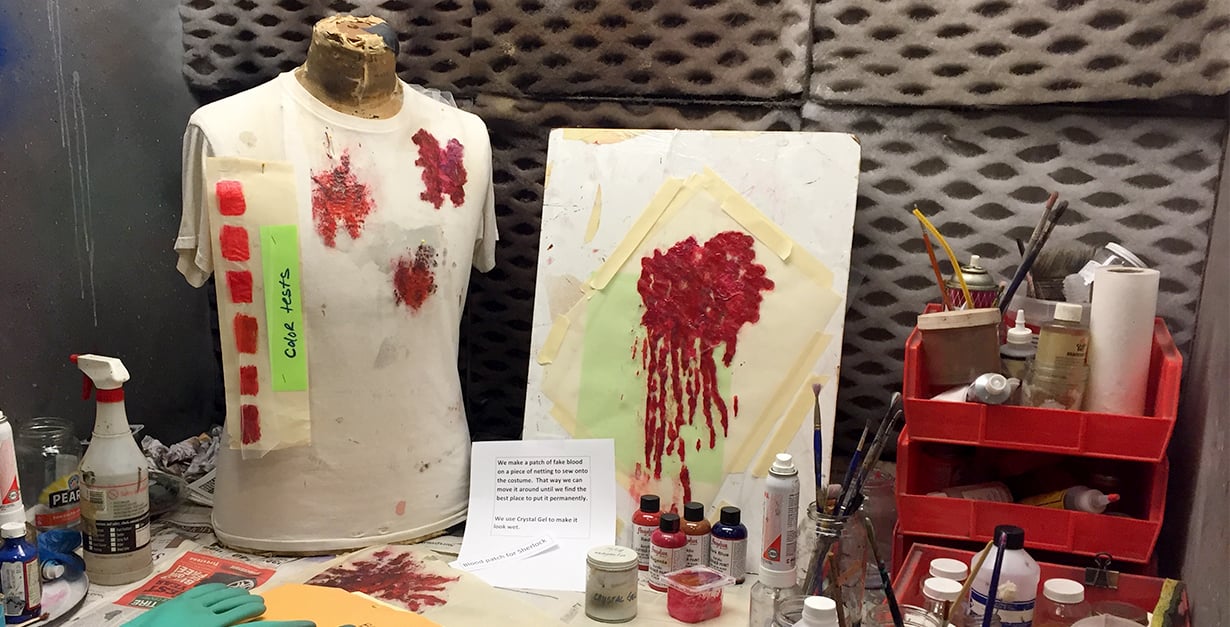Costume Artist Denise Wallace-Spriggs is back with another fantastic use for Rosco CrystalGel! She has used CrystalGel in many of her projects as costume craft artisan/dyer at the Huntington Theatre Company. For example, you can read her last post where she describes slathering a pair of roller skates with glitter-infused CrystalGel. While she was working on that post with us, she also described how she uses CrystalGel to create bloody costume effects. She shares the gory details of her bloody costumes in the article below.
The Huntington Theatre Company was producing Sherlock’s Last Case, by Charles Marowitz. One scene in that play calls for a bloody costume. When a scene calls for fake blood, it can strike fear into the hearts of a costumer. The first thing we all think is, “Please, don’t let it be live.” “Live” is the word we use for wet stage blood. That type of effect not only gets all over the costume that the actor is wearing, it can (and will) also transfer to anything that it comes in contact with. If we can provide an option for the director that appears wet to the audience, but is, in fact, dry, we can save a lot of laundry and what I call ”Pink Shirt Syndrome," which is where the stage blood eventually stains any and all white shirts pink and you have to buy new ones.
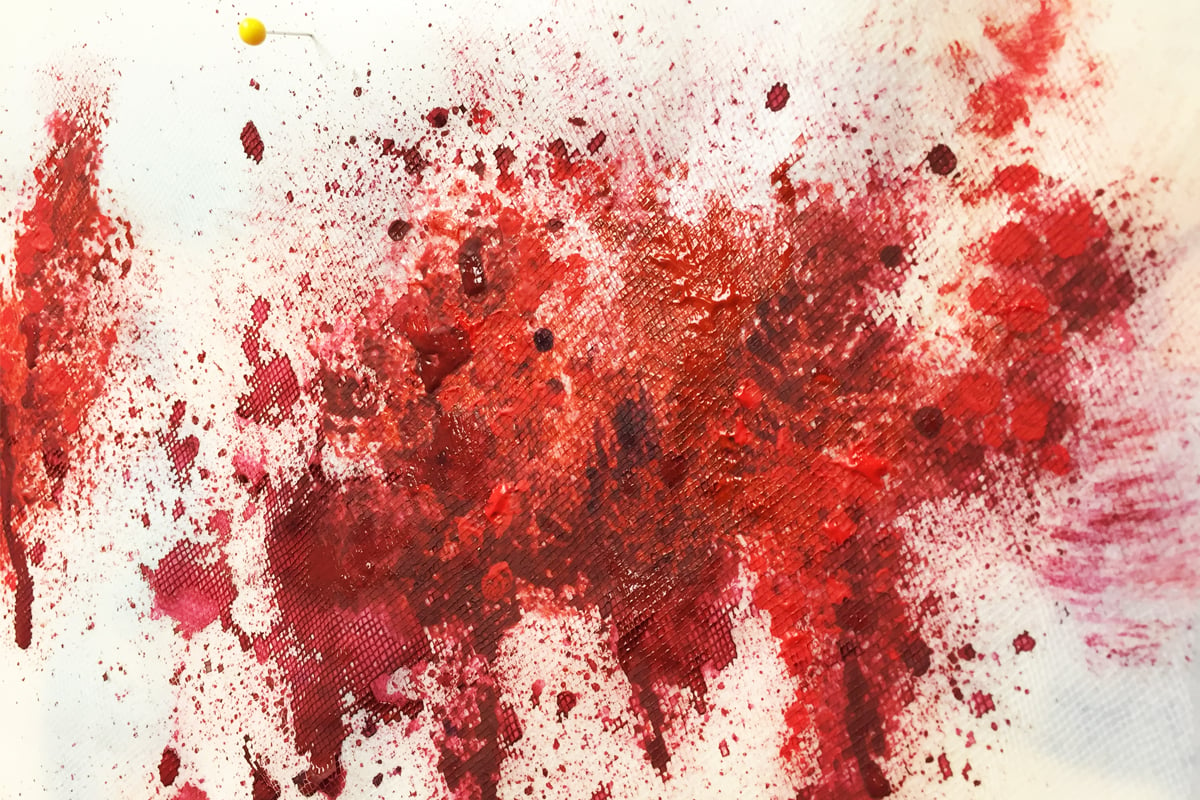 The most important aspects of creating convincing blood effects are; that it looks wet from the stage, that the color is convincing under the lights, that the placement is correct, and that it can be laundered. Oftentimes, a painted effect will look more realistic than a wet blood effect as well because it sits on top of the fabric and doesn’t sink in the way that wet stage blood will.
The most important aspects of creating convincing blood effects are; that it looks wet from the stage, that the color is convincing under the lights, that the placement is correct, and that it can be laundered. Oftentimes, a painted effect will look more realistic than a wet blood effect as well because it sits on top of the fabric and doesn’t sink in the way that wet stage blood will.
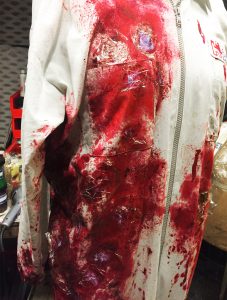 CrystalGel has been one of my go-to topcoats when a scene calls for wet blood. The CrystalGel dries clear and shiny, which makes the fake blood look wet on stage. Because it's dry, this technique doesn't spread the stage blood onto the set and the rest of the costumes around it. Plus, the bloody costumes are washable (we will usually hand wash the item).
CrystalGel has been one of my go-to topcoats when a scene calls for wet blood. The CrystalGel dries clear and shiny, which makes the fake blood look wet on stage. Because it's dry, this technique doesn't spread the stage blood onto the set and the rest of the costumes around it. Plus, the bloody costumes are washable (we will usually hand wash the item).
I have a technique that I use for blood placement that uses a piece of nylon tulle netting as the substrate for painting a bloody stain onto. The tulle is fine enough to be see-through and sturdy enough to hold the paint and CrystalGel. Sometimes we will use this tulle patch to move the blood area around on the costume until the director and the costume designer are happy with the placement. It is a sad thing when you have painted beautiful bloody costumes, only to find that the director would like to re-block the scene with the actors facing the other way and now the blood is on the wrong side of the costume. With this method, you can stitch a bloody patch onto the costumes and keep moving it until everyone has settled upon the look of the scene. Then, if you wish, you can replicate the look directly on the costume. Although, as often as not, we will just sew the patch on very sturdily, and after the show closes we will take it off and use the costume piece again, sans blood.
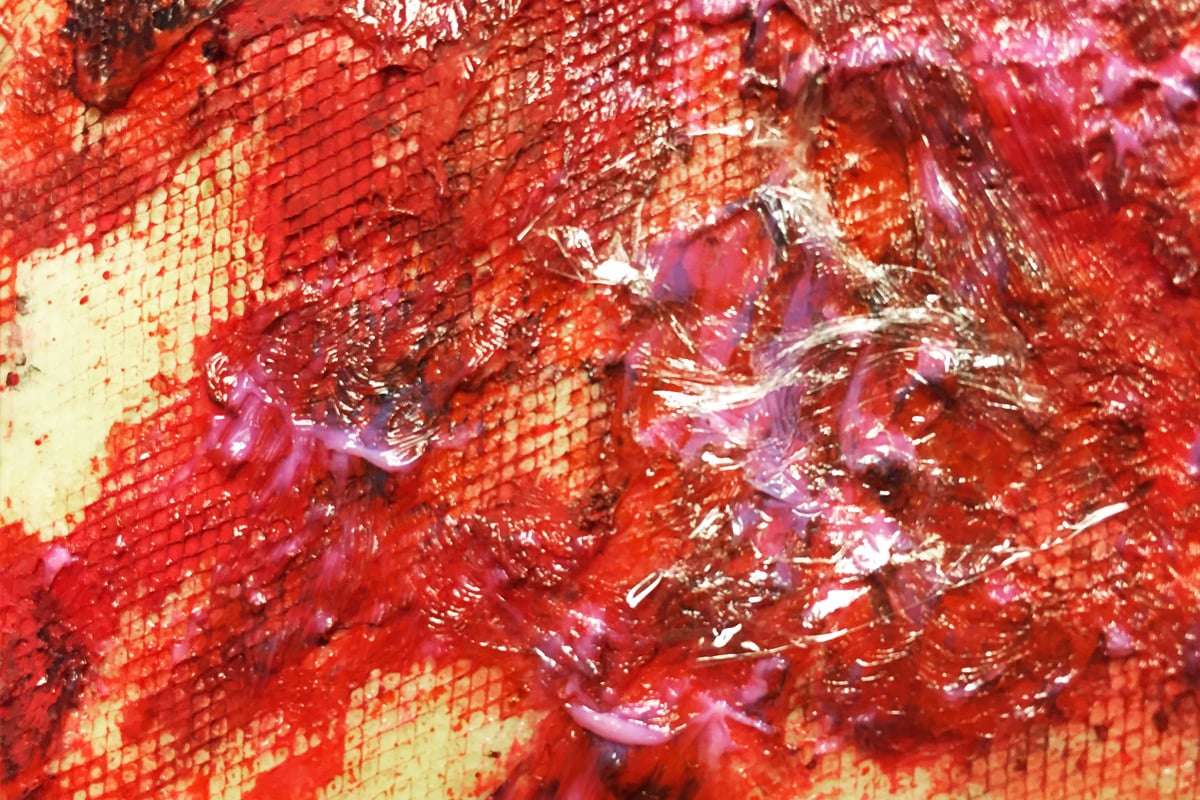 Here is a step by step of the method that I used on a shirt for Sherlock’s Last Case – costumes designed by Fabio Toblini:
Here is a step by step of the method that I used on a shirt for Sherlock’s Last Case – costumes designed by Fabio Toblini:
I have a set of Masonite boards that I use for this type of painting project. Because the CrystalGel sticks to so many things, it requires a release agent. Waxed paper works very well. Prepare your surface by taping down some waxed paper, then draw the outline of your design area with pencil onto the waxed paper (or you can make a drawing of the area to be painted and slip it under the waxed paper) then tape the tulle over that.
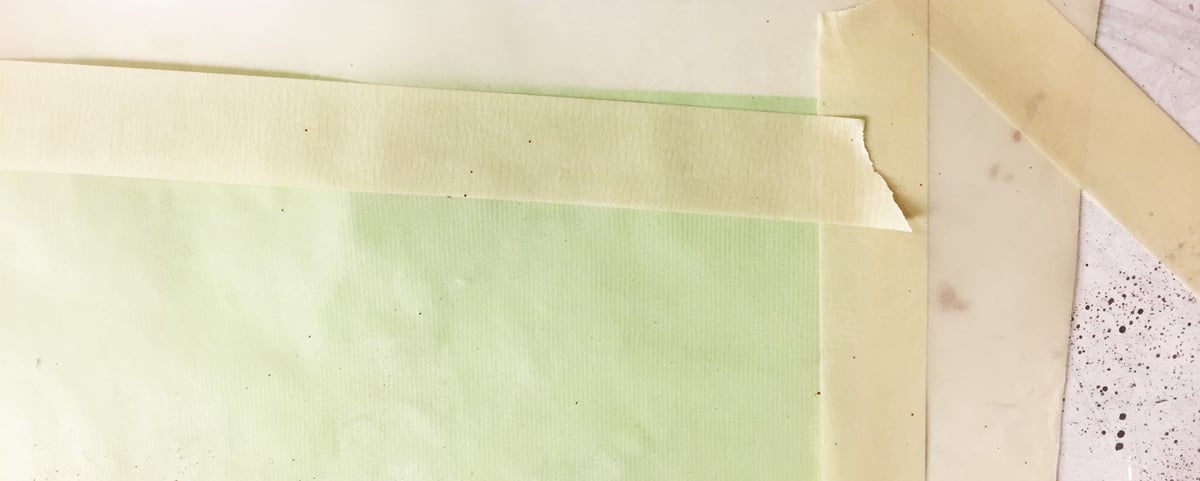 Next, you need to lay down a “mapping” layer to set up the shape of the piece. For dripping effects, use an eyedropper or syringe to spray and drip the pattern onto the tulle with watered-down paint. I like to use Angelus Shoe Paint because it grabs the netting very well and it is very flexible.
Next, you need to lay down a “mapping” layer to set up the shape of the piece. For dripping effects, use an eyedropper or syringe to spray and drip the pattern onto the tulle with watered-down paint. I like to use Angelus Shoe Paint because it grabs the netting very well and it is very flexible.
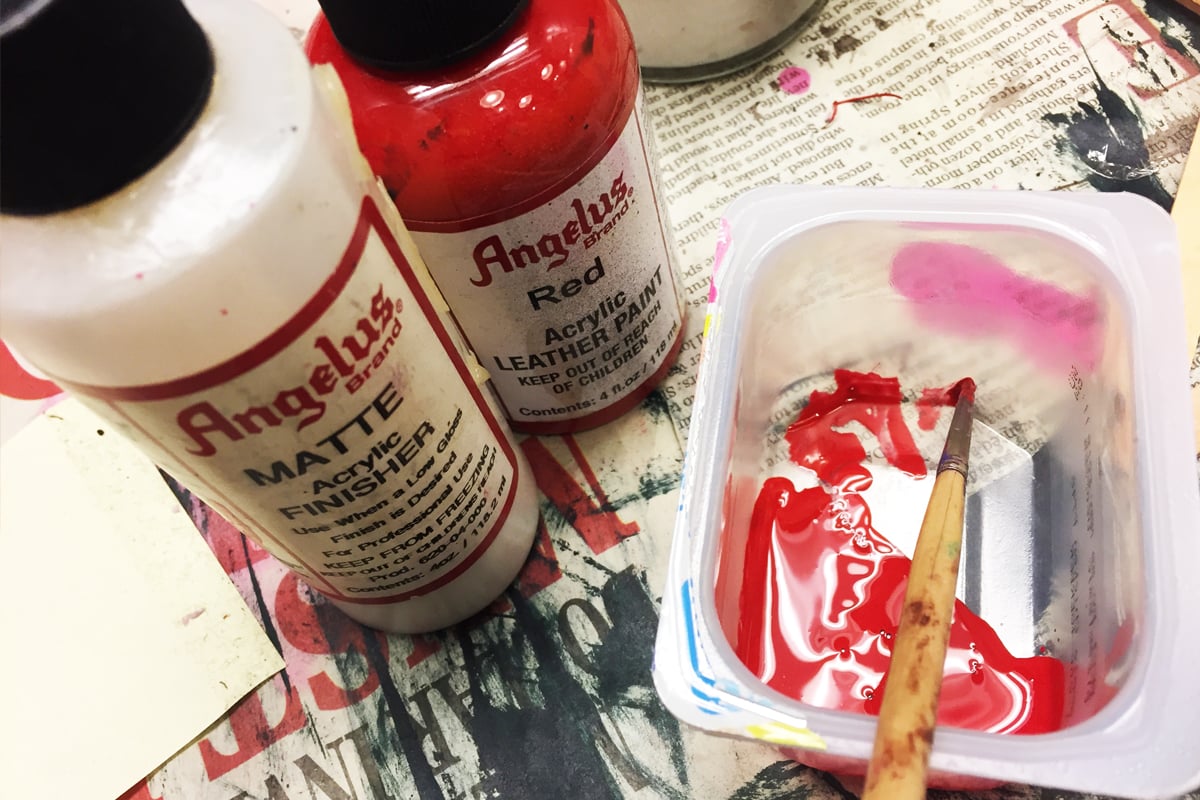 I use one color for this step since it is just for laying out a natural-looking shape, you will adjust the color later. In order to help get nice drips, I prop the board up at an 80-90 degree angle. Be sure to test a drip somewhere to the side to make sure that you have the proper consistency to your paint. It should flow like… well… like blood. Adjust it with water or another medium if you need to. Dry with a hair dryer or fan.
I use one color for this step since it is just for laying out a natural-looking shape, you will adjust the color later. In order to help get nice drips, I prop the board up at an 80-90 degree angle. Be sure to test a drip somewhere to the side to make sure that you have the proper consistency to your paint. It should flow like… well… like blood. Adjust it with water or another medium if you need to. Dry with a hair dryer or fan.
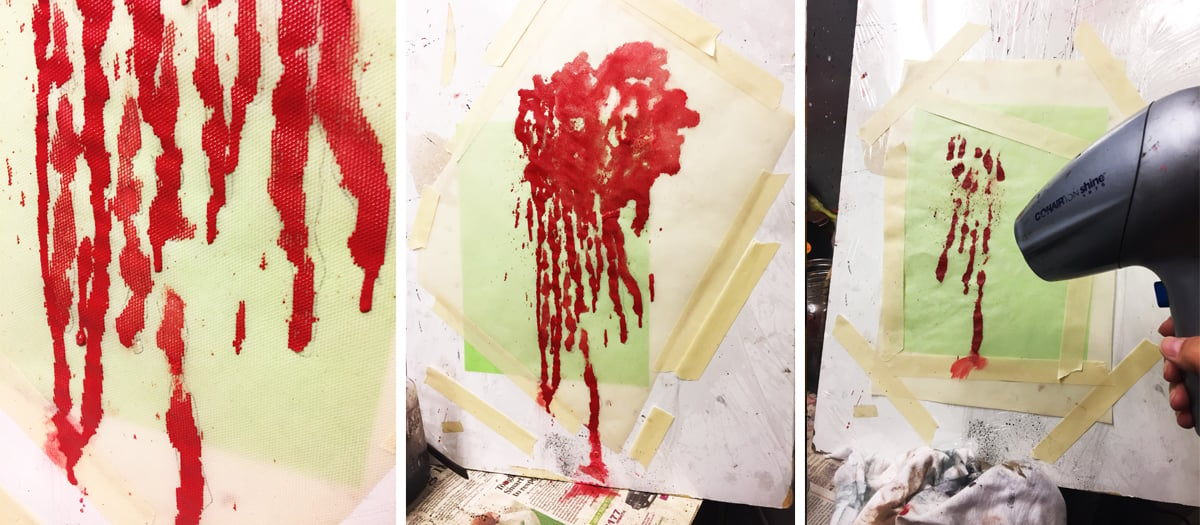 Once the mapping layer is dry, I layer the whole area with CrystalGel that has been tinted with a small amount of red paint. This layer is to add texture to the piece. The texture will catch the stage light and reflect it out to the audience. The more texture you add, the more shiny reflections there will be, and the the more convincingly wet the bloody costumes will appear.
Once the mapping layer is dry, I layer the whole area with CrystalGel that has been tinted with a small amount of red paint. This layer is to add texture to the piece. The texture will catch the stage light and reflect it out to the audience. The more texture you add, the more shiny reflections there will be, and the the more convincingly wet the bloody costumes will appear.
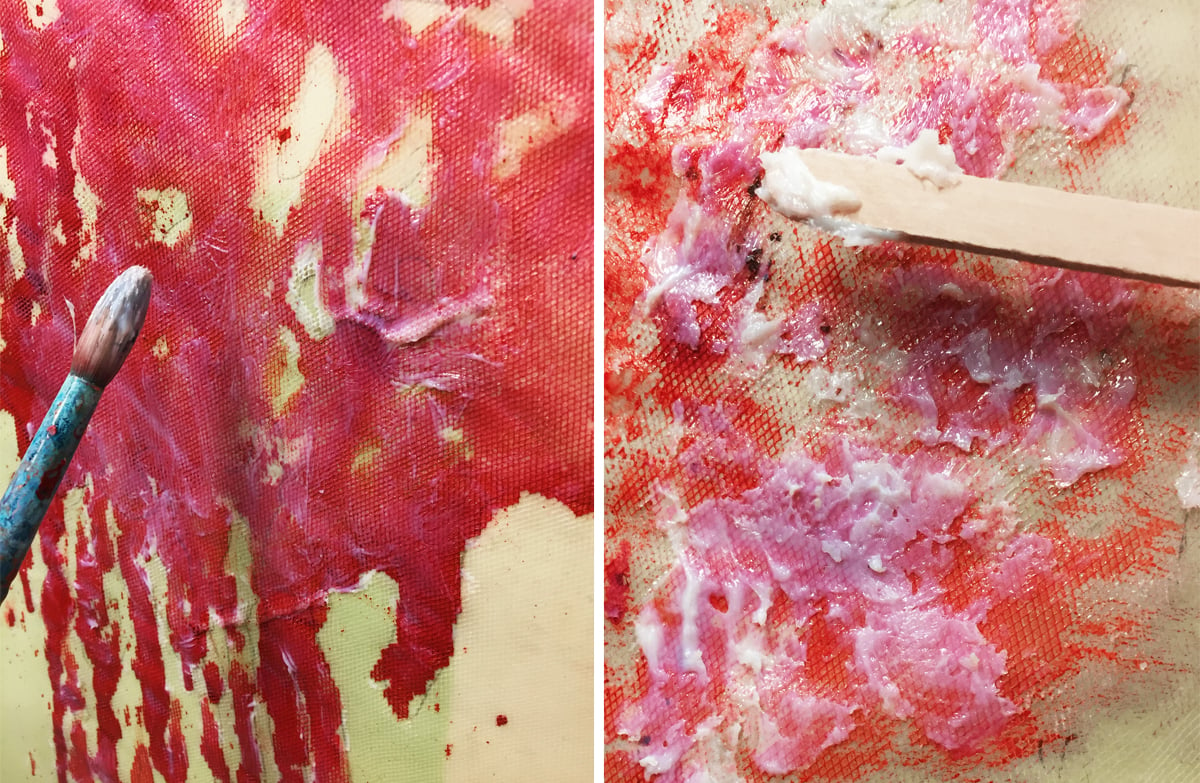 You can tint it with the same Angelus brand paint, or you can use a small drop of leather dye or some transparent fabric paint. Use caution - if you use too much paint in the mix it will make the CrystalGel look dull. The main idea is to keep it fairly sheer in appearance so that subsequent layers will read through each other.
You can tint it with the same Angelus brand paint, or you can use a small drop of leather dye or some transparent fabric paint. Use caution - if you use too much paint in the mix it will make the CrystalGel look dull. The main idea is to keep it fairly sheer in appearance so that subsequent layers will read through each other.
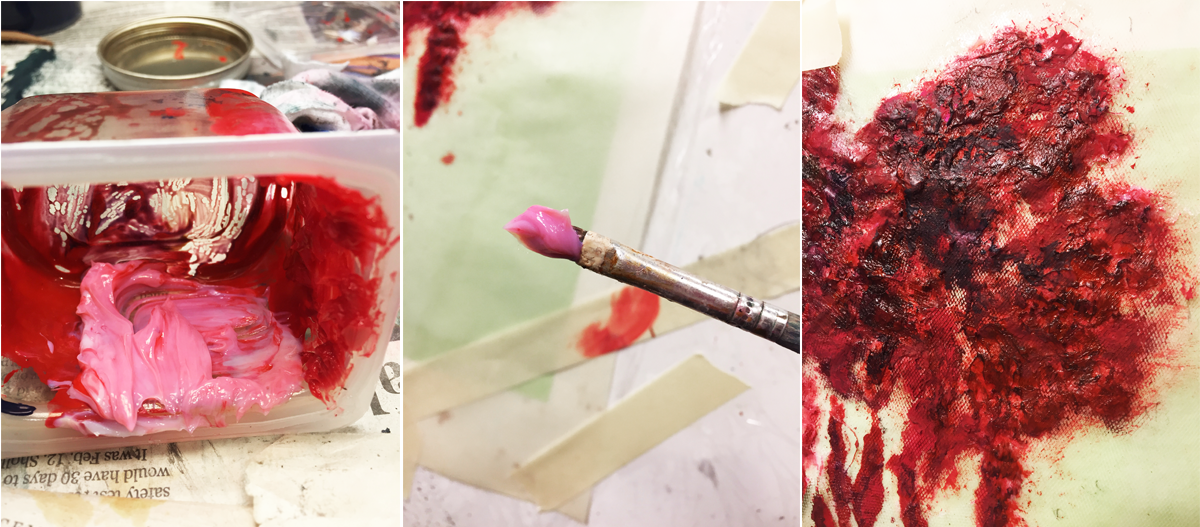 Next, you will want to add some dimension with color. It’s worth noting here that, similar to tinting regular white glue, the white CrystalGel will appear lighter while it’s wet – but rest assured, it will dry darker. It will appear pink, for example, when I mix it with red paint – but it dries a murderous blood red color.
Next, you will want to add some dimension with color. It’s worth noting here that, similar to tinting regular white glue, the white CrystalGel will appear lighter while it’s wet – but rest assured, it will dry darker. It will appear pink, for example, when I mix it with red paint – but it dries a murderous blood red color.
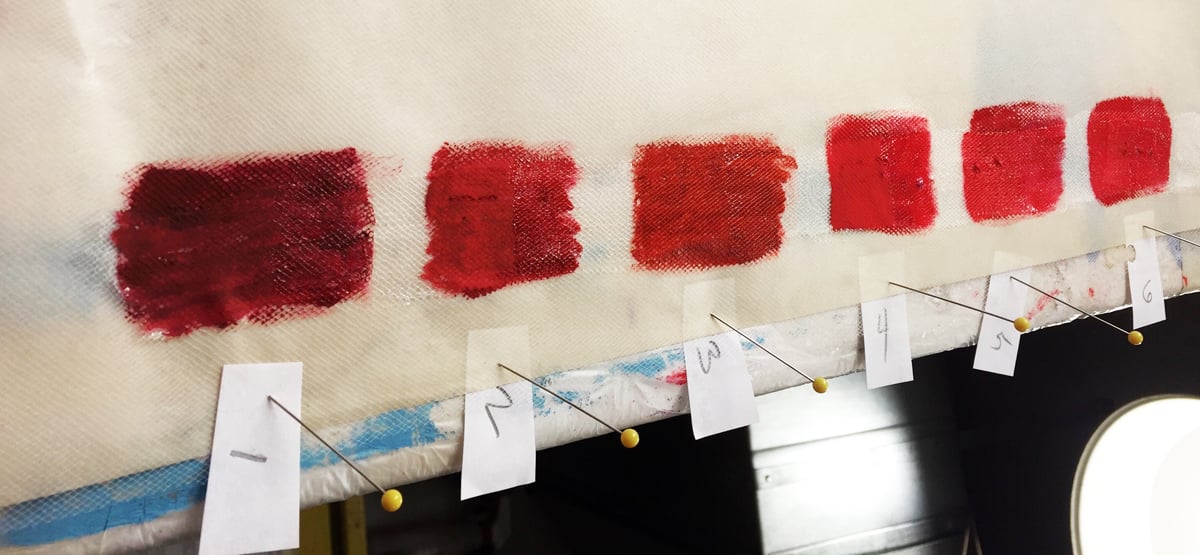 Sometimes, if the Designer is unsure of what color blood to choose, we will also stitch a blood spectrum patch somewhere on the costume to see how the colors read under the stage lighting. It can be amazing how much the colors will change. At this stage, I’ll also mix up some CrystalGel with brown paint and some with blue paint to apply in the shadow areas. Though it sounds unusual, often the lighting will make the red look very dull and the patch may require a bit of magenta paint.
Sometimes, if the Designer is unsure of what color blood to choose, we will also stitch a blood spectrum patch somewhere on the costume to see how the colors read under the stage lighting. It can be amazing how much the colors will change. At this stage, I’ll also mix up some CrystalGel with brown paint and some with blue paint to apply in the shadow areas. Though it sounds unusual, often the lighting will make the red look very dull and the patch may require a bit of magenta paint.
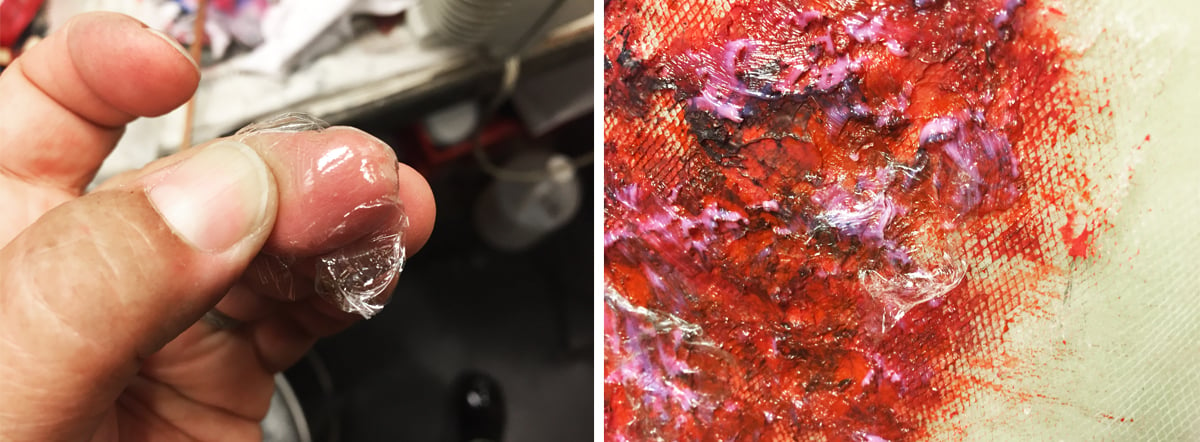 Once we have the colors that we are happy with, I will paint a thin coat of CrystalGel over the whole thing. For added shine, I employ a trick that I learned from my mentor, Barbara Matheson, when we were at Rhode Island College. I apply small bits of plastic wrap to the patch using the CrystalGel as a glue. I find that the plastic wrap picks up the light in a different way than the CrystalGel, and if you need real bang for the buck, you can experiment with adding shards of clear flat sequins into the piece.
Once we have the colors that we are happy with, I will paint a thin coat of CrystalGel over the whole thing. For added shine, I employ a trick that I learned from my mentor, Barbara Matheson, when we were at Rhode Island College. I apply small bits of plastic wrap to the patch using the CrystalGel as a glue. I find that the plastic wrap picks up the light in a different way than the CrystalGel, and if you need real bang for the buck, you can experiment with adding shards of clear flat sequins into the piece.
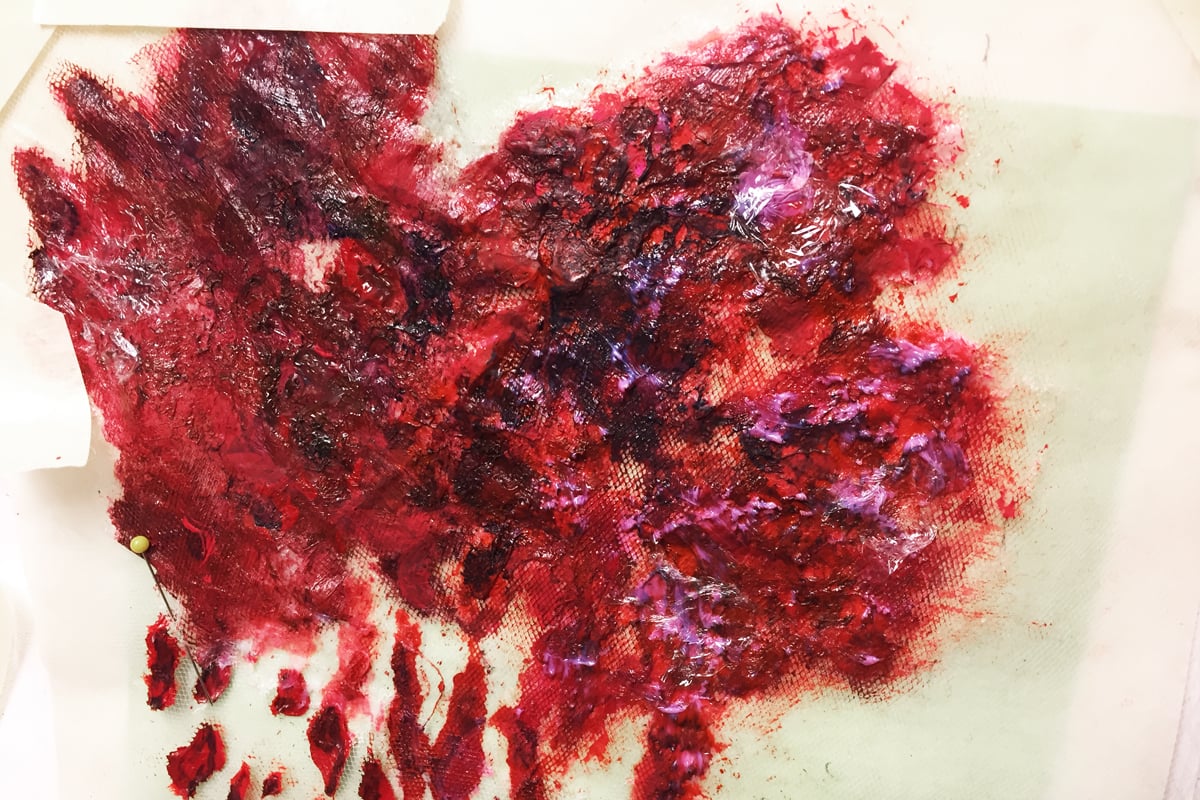 To finish it all up, I peel the piece gently off the waxed paper and flip it over, then paint a layer of the CrystalGel on the back of the tulle to seal it all in.
To finish it all up, I peel the piece gently off the waxed paper and flip it over, then paint a layer of the CrystalGel on the back of the tulle to seal it all in.
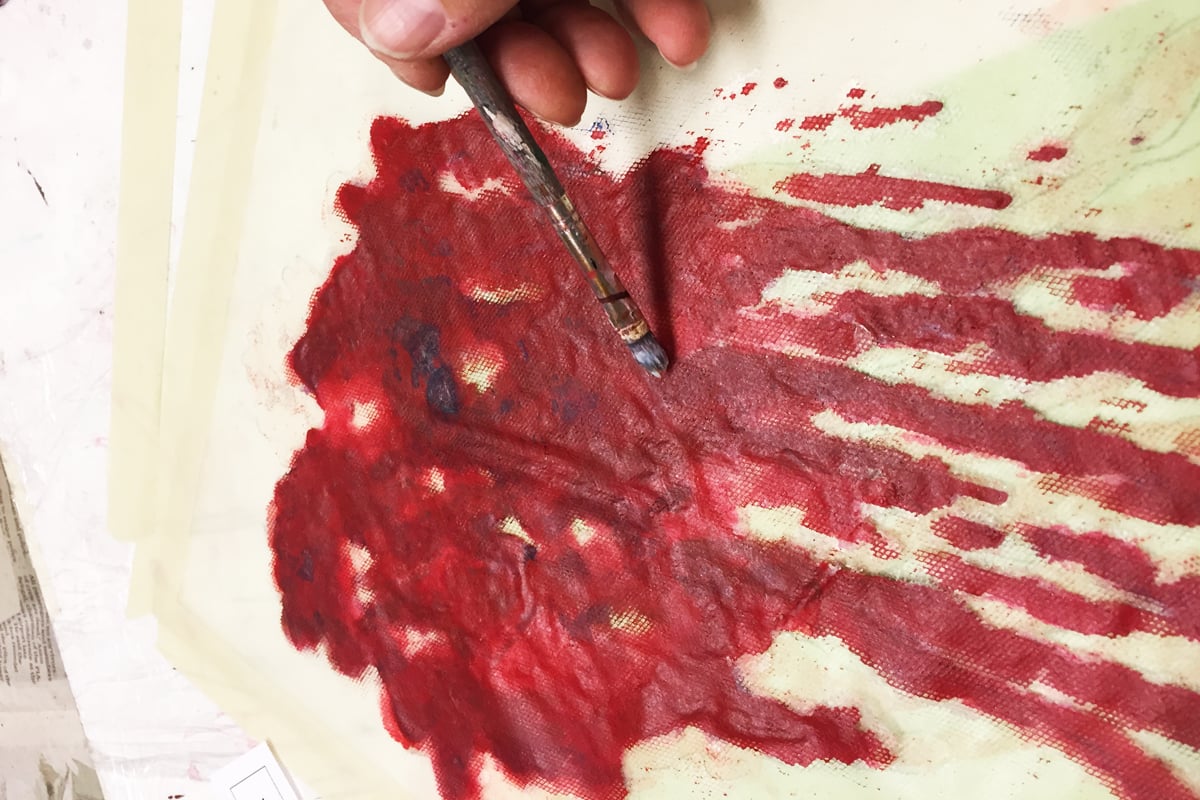 Generally, we sew it onto the costume piece temporarily for the first few rehearsals. Then we may decide to sew it on more sturdily or to paint it directly onto the surface of the costume.
Generally, we sew it onto the costume piece temporarily for the first few rehearsals. Then we may decide to sew it on more sturdily or to paint it directly onto the surface of the costume.
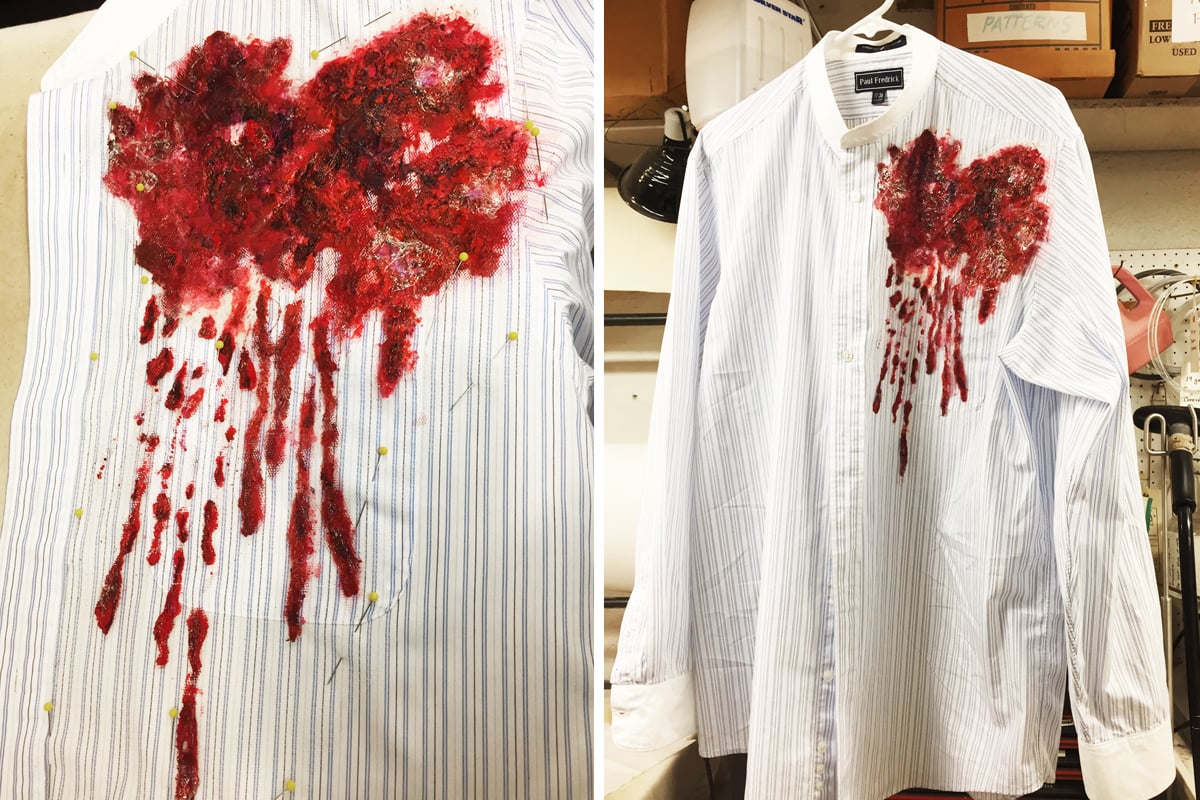 That’s it – you’re done! Be sure to share your recipe with your props department and scene painters as they may want to have the same blood type spattered on the murder weapon or on the area of the set where the body is found. Either way, when the director asks “who dunnit?” when they see the marvelous blood costumes on stage – you can proudly say it was you.
That’s it – you’re done! Be sure to share your recipe with your props department and scene painters as they may want to have the same blood type spattered on the murder weapon or on the area of the set where the body is found. Either way, when the director asks “who dunnit?” when they see the marvelous blood costumes on stage – you can proudly say it was you.
Denise Wallace-Spriggs is a Massachusetts-based costume crafts artisan and has been an integral part of the production team at the Huntington Theatre Company in Boston for almost 30 years. Ms Wallace-Spriggs also has an excellent reputation as a teacher. She is currently a Lecturer at Boston University and she hosts workshops on many craft subjects in her studio in Stoughton, MA and all over the country. To explore more of her work or check on her list of upcoming workshops, you can follow her on Facebook or visit her website: denisewallacespriggs.com.

